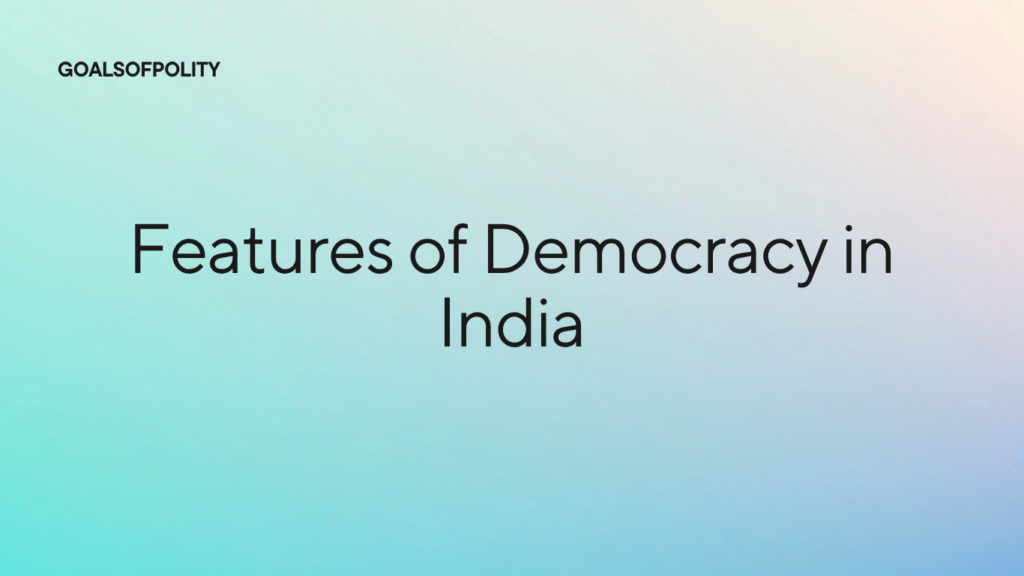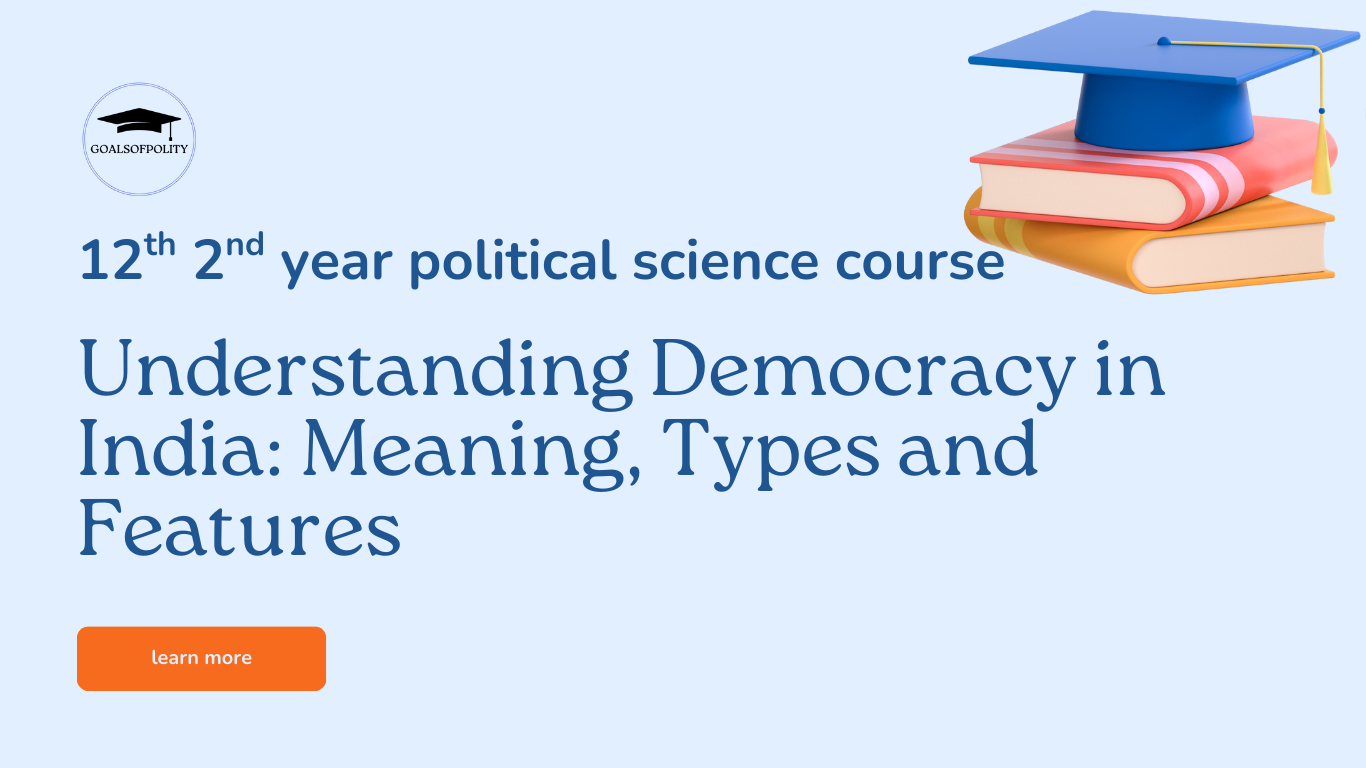Table of Contents
India is often called the world’s largest democracy, thanks to its vast population and its steadfast commitment to democratic ideals. With over a billion citizens belonging to different religions, languages, castes, and communities, India is a unique example of how democracy can function in a society with such immense diversity.
When India gained independence in 1947, its leaders faced the enormous task of nation-building. Instead of adopting an authoritarian model or concentrating power in the hands of a few elites, they chose democracy. This decision was enshrined in the 1950 Constitution, which declared India a sovereign, socialist, secular, and democratic republic.
Democracy in India is not limited to periodic elections. It is about creating a system where every citizen—regardless of their background—has a voice, where leaders are accountable, and where fundamental freedoms are guaranteed. Over the decades, despite numerous challenges, democracy has survived and flourished, making India one of the world’s most vibrant democracies.
Meaning of Democracy in India
Democracy in India can be understood as a system where ultimate power rests with the people. Citizens elect their representatives at various levels—local, state, and national—through free and fair elections. These representatives are accountable to the public and can be replaced through voting if they fail to perform.
The meaning of democracy in India goes beyond elections:
- It ensures that citizens enjoy fundamental rights such as freedom of expression, equality before the law, and religious freedom.
- It emphasizes inclusiveness, providing representation to marginalized communities.
- It provides mechanisms for accountability, transparency, and the rule of law.
In short, Indian democracy is not just about choosing leaders, but also about protecting the dignity, freedom, and equality of every individual.
Democracy: Unveiling the Essence
At its core, democracy embodies governance of the people, by the people, and for the people. It is a system where power emanates from the collective will of the citizens, often exercised through elected representatives. It stands tall on the pillars of equality, freedom, and participation, providing a framework for inclusive governance and social progress.
Types:
Within its framework, Indian democracy encompasses various forms and operates at multiple levels. India is a unique example because of its Constitution and democratic norms.
1. Parliamentary Democracy
- India follows a parliamentary system similar to the United Kingdom.
- The executive (Prime Minister and Council of Ministers) is accountable to the legislature (Parliament).
- The government remains in power as long as it enjoys a majority in the Lok Sabha.
Feature: Continuous accountability of the executive to the legislature.
2. Federal Democracy
- India is a union of states, where powers are divided between the central government and state governments.
- The Union List, the State List, and the Concurrent List are the three lists used by the Constitution to allocate authority.
- Although federal in structure, this system has a unitary tendency to maintain national unity.
Feature: Balance between central authority and state autonomy.
3. Representative Democracy
- Citizens elect representatives at all levels—local (panchayats and municipalities), state (legislative assemblies), and national (Parliament).
- These representatives make laws and policies on behalf of the public.
Feature: Ensures representation of diverse groups and interests in governance.
4. Secular Democracy
- India has no state religion, and all religions are treated equally.
- Every citizen has the right to practice, propagate, and propagate their religion.
- The state remains neutral on religious matters.
Feature: Harmony and equality in a multi-religious society.
5. Social Democracy
- Indian democracy prioritizes social and economic fairness along with political representation.
- Special provisions such as reservations in jobs and education uplift poor communities.
- Welfare schemes such as free schooling, healthcare, and poverty alleviation reflect this dimension.
Feature: Strives to reduce inequality and promote inclusive development.
6. Direct Democracy at the Local Level
- Although this system is primarily representative, elements of direct democracy exist at the grassroots level.
- Through the Panchayati Raj system, citizens of villages directly participate in decision-making in Gram Sabhas.
Feature: Promotes direct public participation in governance.
7. Multi-party Democracy
- India has a vibrant multi-party system. Citizens can choose from parties with different ideologies.
- Coalition governments at both the central and state levels demonstrate how diverse political views are accommodated.
Feature: Ensures choice and competition in governance.
Features:
Democracy in India has distinctive features that ensure its survival and success in a diverse society.

1. Universal Adult Suffrage:
The democratic fabric is woven with the principle of universal adult suffrage, which gives every citizen above a certain age the right to vote without any discrimination. This feature ensures the inclusiveness of the electoral process, allowing diverse voices to contribute to the governance of the nation.
2. Fundamental Rights and Freedoms:
A strong democracy guarantees fundamental rights and freedoms to its citizens, protecting them from arbitrary actions of the state and ensuring their dignity and independence. The Constitution contains a comprehensive list of fundamental rights, including the right to equality, freedom of expression, and the right to constitutional remedies.
3. Multi-Party System:
Plurality of voices is the hallmark of democracy, which is manifested through its vibrant multiparty system. Political parties representing different ideologies, regions, and interests compete for power through electoral contests, thereby promoting healthy competition and accountability in governance.
4. Independent Judiciary:
An independent judiciary acts as the guardian of the rule of law by upholding it and ensuring justice for all. India’s judiciary, with its hierarchical structure and constitutional mandate, acts as a check on the executive and legislative branches while protecting the rights and liberties of citizens.
5. Federal Structure:
The federal structure delimits powers between the central and state governments, strengthening the democratic ethos by decentralizing authority and promoting local self-governance. This system accommodates regional diversity and strengthens grassroots democracy, thereby promoting socio-economic development across the country.
6. Popular Sovereignty
The people have the ultimate authority. They can elect, change, or reject governments through voting.
7. Parliamentary System
The Prime Minister and the Council of Ministers are accountable to Parliament, which ensures checks on the power of the executive.
8. Rule of Law
No person, not even the highest authority, is above the law. Equality before the law is the cornerstone of Indian democracy.
9. Secularism
In India’s multi-religious society, equal respect for all religions ensures peace.
10. Regular Elections
An independent Election Commission ensures regular, free, and fair elections.
11. Minority Protection
Religious, linguistic, and cultural minorities are protected under special provisions of the Constitution.
12. Decentralization
Power is devolved to Panchayati Raj institutions and urban local bodies, strengthening local governance.
The Importance of Democracy in India
Democracy in India has far-reaching significance:
- Unity in Diversity: It provides space for various communities to coexist peacefully.
- Social Justice: The advancement of marginalized populations is facilitated through special measures.
- Stability: Despite challenges, India has remained a stable democracy since its independence.
- Global Example: India’s success as a democracy inspires other developing countries.
- Citizen Empowerment: It ensures that every citizen has a voice in shaping policies and governance.
Challenges to Democracy in India
Although India has a strong democratic framework, it still faces several challenges:
- Corruption in public life undermines trust in institutions.
- Criminalization of politics affects the quality of leadership.
- Communalism and casteism sometimes disrupt secular harmony.
- Economic inequality limits true equality of opportunity.
- Misinformation and populism influence voter behavior.
- Low voter awareness leads to apathy in democratic participation.
To address these, reforms, civic education, and strengthening democratic institutions are needed.
Conclusion:
Democracy in India is not just a political system, but a vibrant tradition that reflects the values of equality, freedom, and justice. It has survived despite enormous challenges, primarily because it responds to the aspirations of its citizens.
By combining parliamentary practices, federal principles, secular values, and social justice, India has built a system that maintains a balance between unity and diversity. Its success lies not only in holding regular elections, but also in empowering people, protecting their rights, and adapting to changing times.
The journey of Indian democracy is constantly evolving, but its foundation remains strong: a government of the people, by the people, and for the people.
FAQs:
1. What are the main features of democracy in India?
The main features include the rule of law, political participation, equality, and accountability.
2. How does the media contribute to Indian democracy?
The media contributes by disseminating information, promoting public debate, and holding authorities accountable.
3. What are the challenges facing democracy in India?
Challenges include corruption, electoral malpractices, and socio-economic inequalities.
4. How can India enhance its democratic prospects in the future?
India can enhance the prospects by adopting digital democracy, enhancing civic education and addressing socio-economic inequalities.

